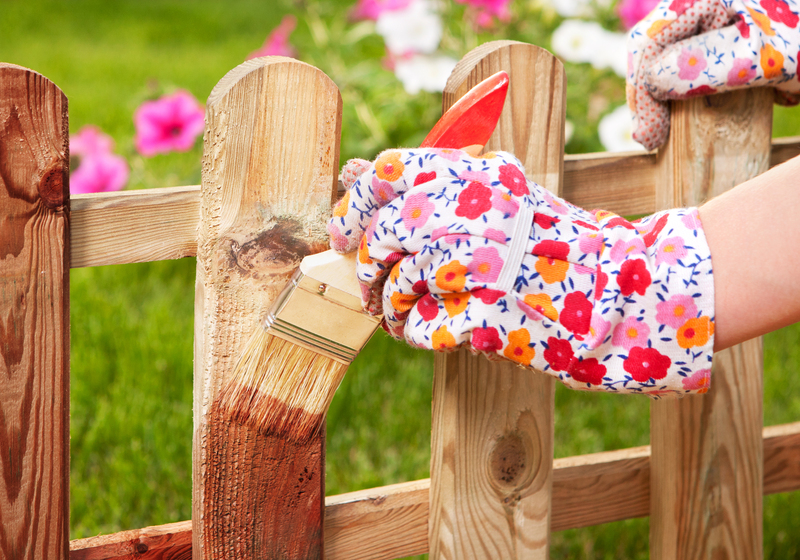Designing Engaging and Imaginative Gardens for Children
Posted on 26/09/2025
Designing Engaging and Imaginative Gardens for Children
Creating a garden space for children can unlock a world of adventure, curiosity, and creativity. Far from being just a visual retreat for adults, a thoughtfully planned garden can serve as an outdoor playroom, classroom, and laboratory where young minds flourish. This article serves as a comprehensive guide to designing engaging and imaginative gardens for children, providing practical advice and inspiring ideas to captivate kids while fostering a genuine love for nature.
Why Focus on Children's Gardens?
Children today often spend more time indoors and less time interacting with the natural world. Having a dedicated children's garden is vital for their physical health, mental wellbeing, and overall development. Such gardens offer:
- Hands-on experiences: Encouraging curiosity about plants, insects, and cycles of nature.
- Active play: Stimulating imaginative games and physical movement.
- Emotional growth: Fostering responsibility, empathy, and confidence through nurturing living things.
- Learning opportunities: Bringing core subjects like science, math, and art to life.

Key Elements of an Engaging and Imaginative Children's Garden
1. Safe and Accessible Spaces
Safety is paramount when designing gardens for kids. Ensure all pathways are even and slip-resistant, fences are secure, and there are no poisonous plants or hazardous materials within reach. Accessibility matters, so consider wheelchair-friendly paths and raised beds for children with limited mobility.
2. Sensory-Rich Planting
A truly captivating imaginative garden appeals to all the senses. Incorporate a mix of:
- Sight: Vibrant flowers, whimsical garden art, and playful colors
- Touch: Fuzzy lamb's ear, smooth river stones, and bumpy gourds
- Scent: Aromatic herbs like lavender, mint, or lemon balm
- Sound: Grasses that rustle in the wind, wind chimes, or a small water feature
- Taste: Edible plants such as cherry tomatoes, strawberries, or snap peas
3. Zones for Play and Exploration
Imaginative gardens for children thrive on the freedom to roam, discover, and invent games. Consider these zones:
- Active play: Swings, climbing frames, or log stepping stones
- Quiet retreat: A cozy teepee, reading nook, or secluded bench
- Discovery area: Bug hotels, digging patches, or a sensory path
- Creative station: Outdoor easels, mud kitchens, or sandpits
Design Principles for Child-Friendly Gardens
Engaging Layouts
Rather than straight lines and formal beds, opt for meandering paths, hideaways, and circular spaces. These encourage exploration and play rather than just observation. Encourage a sense of adventure with winding trails, hidden nooks, and garden tunnels made of willow or bamboo.
Inclusivity and Adaptability
The best children's gardens are inclusive, adaptable spaces. Adjustable planters, sensory gardens, and accessible activities ensure every child finds joy and learning, regardless of their abilities.
Edible Elements
Plant simple crops or fruit bushes that are safe and easy for children to care for and harvest. Raised beds or container gardens can make planting and picking produce manageable even for the smallest hands.
Inspiring Ideas for Imaginative Garden Features
Wildlife Havens
Transform your child-friendly landscape into a haven for butterflies, bees, and birds. Install bird feeders, build insect hotels, and plant nectar-rich flowers. A mini pond or log pile can spark countless hours of nature-watching.
Living Tunnels and Huts
Grow climbing beans or sweet peas over willow or bamboo frameworks to create magical tunnels and hideaways. These living structures encourage play and provide shady spots for reading or quiet reflection.
Storybook Corners
Set up a quiet reading nook with waterproof beanbags, a small bookshelf, and windproof storybooks tucked beneath a tree or pergola. Incorporate story-themed sculptures or fairy doors for added whimsy.
Mud Kitchens and Sand Pits
Encourage tactile imaginative play with distinctly messy zones. Homemade mud kitchens, complete with old pots, wooden spoons, and herbs, invite kids to concoct their own outdoor "recipes." Sand pits spark creativity and offer endless possibilities for building and exploration.
Sensory Paths
Create winding trails filled with textures--pebbles, bark chips, grass, tiles--encouraging barefoot exploration and developing balance.
Choosing the Best Plants for Kids' Gardens
Prioritize child-friendly plants that are non-toxic, robust, and offer sensory delight. Some favorites include:
- Sunflowers: Fast-growing and dramatic, perfect for planting a sunflower "house."
- Runner beans: Great for growing up wigwams or tunnels.
- Calendula (Pot Marigold): Edible petals and cheerful color.
- Strawberries: Easy to grow, delicious, and rewarding for little gardeners.
- Pumpkins: Fascinating to watch grow and fun to harvest in the fall.
- Lamb's ear: Its soft, woolly leaves invite touching.
- Sensory herbs: Mint, basil, chives, and thyme--all aromatic and edible.
Safety and Sustainability Considerations
Non-Toxic and Allergy-Aware Plants
Always double-check plant choices to ensure they are safe around children. Avoid plants with toxic berries, thorns, or sap. Review garden plans with parents or guardians, particularly if children have allergies.
Eco-friendly Practices
Teach children respect for the environment by making your garden as sustainable as possible:
- Compost garden waste
- Collect rainwater for irrigation
- Use peat-free compost
- Choose native, drought-tolerant, or pollinator-friendly plants
- Avoid pesticides--promote natural pest control instead
Engaging Children in the Design Process
The secret to a truly engaging children's garden is involving kids in the planning and ongoing maintenance. Here's how you can nurture their ownership and creativity:
- Brainstorm together: Ask children what features, colors, or play spaces they'd love in their garden.
- Personalize: Let kids paint plant markers, make garden signs, or select seeds.
- Plan regular activities: Organize planting days, scavenger hunts, or garden parties.
- Share successes: Record growth with a garden journal or photo diary; celebrate harvests together.
Tips for Maintaining Interest Year-Round
For a magical, imaginative garden that keeps kids coming back, include features that delight during all seasons:
- Spring: Bulbs for early color and simple vegetable sowing projects.
- Summer: Water play, shady hideouts, and summer-flowering plants.
- Autumn: Leaf piles, pumpkin harvest, and wildlife watching.
- Winter: Evergreen textures, berry-laden shrubs for birds, and wind chimes.
Creative Activities to Enrich the Garden Experience
- Nature art: Use twigs, leaves, and pebbles to create collages or sculptures.
- Mini wildlife surveys: Keep a tally of different birds and bugs spotted during the week.
- DIY garden projects: Build fairy houses, bug hotels, or painted rocks.
- Outdoor performances: Encourage drama and storytelling with a simple "stage" area.
- Grow-and-eat experiments: Sprout salad leaves in small pots to taste the results.
Overcoming Common Challenges in Child-Friendly Garden Design
Space constraints: Even tiny urban balconies can host imaginative container gardens--a few pots with edible plants, fairy lights, and vertical wall planters work wonders.
Limited budget: Upcycle materials for planters or play equipment, swap seeds and cuttings with neighbors, and engage local businesses for support.
Keeping interest alive: Plan new activities each month, introduce competitions ("Who finds the first ladybug?"), or rotate features to match seasonal changes.

Case Studies: Incredible Children's Gardens for Inspiration
1. The Chelsea Children's Garden
This famous show garden delights visitors with intertwining willow tunnels, a mini wildflower meadow, bright stepping stones, and bug hotels tucked amid lush greenery. Its success proves that creative garden design can engage all ages.
2. School Community Gardens
Around the world, school gardens blend raised beds, edible landscapes, and outdoor classrooms--demonstrating how imaginative gardening can transform learning and social experiences for children.
Conclusion: Letting Children's Imaginations Bloom
A truly engaging and imaginative children's garden is more than the sum of its parts. Whether you have a sprawling backyard or a compact patio space, the thoughtful inclusion of sensory-rich plantings, zones for play and discovery, and ample opportunities for creative involvement ensures children will cherish their time in the garden.
By prioritizing safety, inclusivity, and sustainability, and intentionally designing spaces that celebrate wonder, you create a nurturing environment where young gardeners can thrive. Remember, the magic of a children's garden is not only in its blossoms, but in the laughter, learning, and wild imagination it cultivates beneath the open sky.
Start Designing Your Child's Garden Adventure Today!
Draw on these ideas to create your own engaging and imaginative garden for children. Involve kids from the planning stages, encourage play and exploration, and your garden will become a lifelong source of joy and inspiration.

